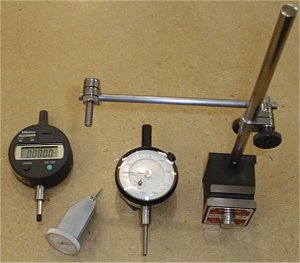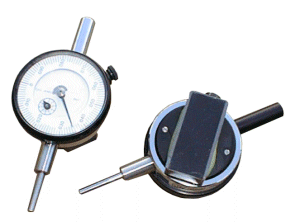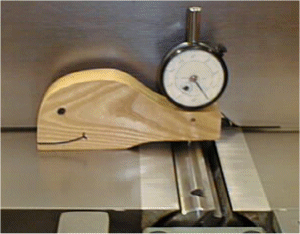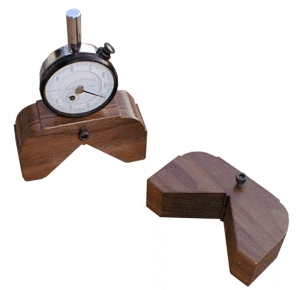|
|
|
| Dial indicators are generally thought of as measuring devices for machinists. While this trade uses and needs these devices they are still useful tools for setting up woodworking machines and for a few other uses as well. Shown below are a few jig bases that allow indicators to be used in the setup of woodworking machines. |
| Pictured at right are few different dial indicators. The
one on the far left is a digital version of a standard dial indicator, the one to its
right is what is known as a "test" dial indicator. A test indicator
usually has a resolution about 10 times greater than a standard dial indicator, this one
can measure in tenths of a thousandth of an inch. The indicator with the white face
is a standard indicator. A common accessory for a dial indicator is what is known as a "magnetic base" (far right). This most often refers to a switch able magnetic block with two arms attached to the block. The indicator is itself attached to these arms in a position useful for whatever operation desired. |
 |
 |
Magnetic bases are useful but sometimes they are more than what
is truly needed. Shown here are two indicators which have large magnets glued to their
back panels. I've placed a piece of black electricians tape on the bottom of the magnet to
help protect the magnet as well as to ensure that it cannot scratch a surface it is placed
on. An example of an application for this sort of indicator setup would be to measure the position repeatability of a rip fence. With one indicator a reference can be set then the fence moved several timed to the "same" spot. Deviations are easily observed. With two indicators not only can one measure position repeatability but angular repeatability can be measured as well. It is possible to buy a standard back with a magnet already installed. |
 |
|
| Using wood it is possible to make dial holders as nice or
fanciful as you wish, you can also easily incorporate things such as magnets as an aid in
their use. This is an example of a gauge used to set the height of jointer knives. In the
bottom right view note the magnets which keep the "light" end of the jig in
place while the dial indicator does its job. Also note that there are two of these bases. One reason for this is that it allows me to use two indicators at the same time. When setting knives for instance an adjustment at one end of the blade WILL have an effect (small but measurable by an indicator) at the other end of the blade. Two indicators make these sort of alignment a little nicer to perform; besides, they are usually made of scrap and it doesn't take any more time to make a second one. A measured drawing ans SketchUp model for this jig can be found here. |
| This indicator is held in
a Vee block (made of Walnut). This sort of device is very handy for setting planer knives
relative to the cutter head. A note about the use of wood with these jigs. Wood is handy
but far from perfect for use with a precision instrument. Having said that however for the
accuracy's one would need for aligning woodworking tools it is would seldom present a
problem. A measured drawing ans SketchUp model for this jig can be found here. |
 |